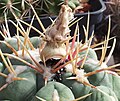| Thelocactus hexaedrophorus | |
|---|---|

| |
| Conservation status | |
 Least Concern (IUCN 3.1) | |
| Scientific classification | |
| Kingdom: | Plantae |
| Clade: | Tracheophytes |
| Clade: | Angiosperms |
| Clade: | Eudicots |
| Order: | Caryophyllales |
| Family: | Cactaceae |
| Subfamily: | Cactoideae |
| Genus: | Thelocactus |
| Species: | T. hexaedrophorus |
| Binomial name | |
| Thelocactus hexaedrophorus (Lem.) Britton & Rose 1922 | |
| Synonyms | |
List
| |
Thelocactus hexaedrophorus is a species of cactus. It is endemic to Mexico.
Description
Thelocactus hexaedrophorus grows solitary, it is a spherical cactus, 3 to 7.5 cm (1.2 to 3.0 in) tall and 8 to 15 cm (3.1 to 5.9 in) in diameter, with a bluish, olive-green, or gray-green body. It has 8 to 13 ribs dissolved into warty, six-sided tubercles, 8 to 20 mm (0.31 to 0.79 in) long and 13 to 26 mm (0.51 to 1.02 in) wide. Areoles are 4 to 13 mm (0.16 to 0.51 in) long, spaced 2 to 3.5 cm (0.79 to 1.38 in) apart. The plant features 4 to 8 radial spines, 5 to 60 mm (0.20 to 2.36 in) long, in colors ranging from white to ocher, reddish, or brown, and a central spine 2 to 3 cm (0.79 to 1.18 in) long. Flowers are large, 5 to 10 cm (2.0 to 3.9 in) wide, ranging from white to pale pink. The fruits are green to magenta, 7 to 11 mm (0.28 to 0.43 in) in size, and dry when open.
Distribution
Thelocactus hexaedrophorus is endemic to the limestone slopes in the Chihuahuan Desert, savanna, and grasslands of San Luis Potosí, Zacatecas, Tamaulipas, and Nuevo León, Mexico at elevations between 1100 and 2000 meters. Plants are found growing along with Mammillaria parkinsonii, Mammillaria aureilanata, Ariocarpus retusus, Turbinicarpus saueri subsp. knuthianus , Coryphantha maiz-tablasensis, Astrophytum myriostigma, Echinocactus platyacanthus, Echinocereus enneacanthus var. carnosus, Coryphantha cornifera, Ferocactus latispinus, Echinocereus pectinatus, Echinocereus cinerascens, Opuntia rastrera, Opuntia lindheimeri, Cylindropuntia imbricata, Myrtillocactus geometrizans, Polaskia chende, Agave salmiana, Yucca filifera, Jatropha dioica and Fritillaria affinis.
-
 Plant growing in Guadalcázar, San Luis Potosí
Plant growing in Guadalcázar, San Luis Potosí
-
 Plant growing near La Muralla, San Luis Potosí
Plant growing near La Muralla, San Luis Potosí
Taxonomy
The plant was first described as Echinocactus hexaedrophorus by Charles Lemaire in 1839, and later placed in the genus Thelocactus by Britton and Rose in 1922. The specific epithet hexaedrophorus is derived from the Greek words hexa- for 'six', hedra for 'level' and -phoros for 'bearing' and refers to hexagonal warts of the species.
References
- Sotomayor, M.; Gómez-Hinostrosa, C.; Hernández, H.M.; Smith, M. (2017). "Thelocactus hexaedrophorus". IUCN Red List of Threatened Species. 2017: e.T151807A121568275. doi:10.2305/IUCN.UK.2017-3.RLTS.T151807A121568275.en. Retrieved 11 November 2021.
- Anderson, Edward F. (2001). The Cactus Family. Portland, Or: Timber Press (OR). p. 660. ISBN 0-88192-498-9.
- "Thelocactus hexaedrophorus". LLIFLE. 2013-08-04. Retrieved 2024-09-15.
 This article incorporates text from this source, which is available under the CC BY-SA 3.0 license.
This article incorporates text from this source, which is available under the CC BY-SA 3.0 license.
- Lemaire, Charles Antoine (1839). Cactearum genera nova speciesque novæ et omnium in Horto monvilliano cultarum ex affinitatibus naturalibus ordinatio nova indexque methodicus /. Lutetiis-Parisiorum: J. Loss. doi:10.5962/bhl.title.124858.
- Club., Torrey Botanical (1922). "Bulletin of the Torrey Botanical Club". Torrey Botanical Club. Retrieved 2024-09-15.
External links
 Media related to Thelocactus hexaedrophorus at Wikimedia Commons
Media related to Thelocactus hexaedrophorus at Wikimedia Commons Data related to Thelocactus hexaedrophorus at Wikispecies
Data related to Thelocactus hexaedrophorus at Wikispecies
| Taxon identifiers | |
|---|---|
| Thelocactus hexaedrophorus |
|
| Echinocactus hexaedrophorus | |




